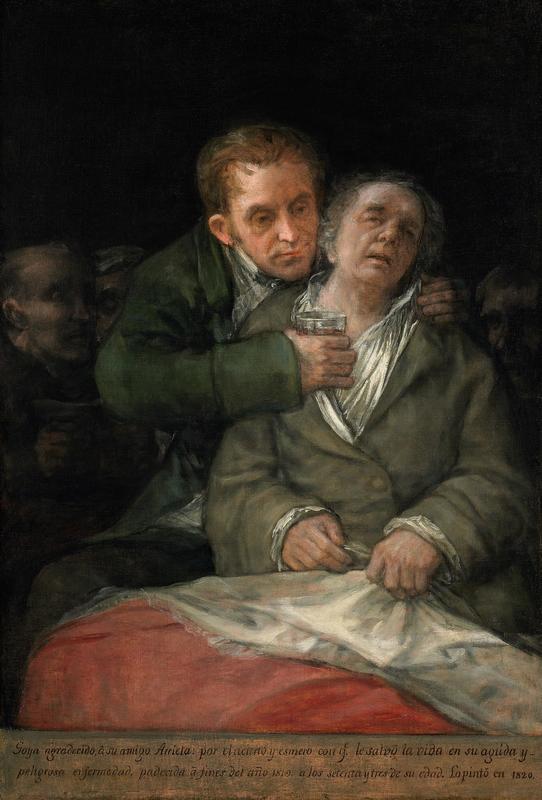More about Self-Portrait with Dr. Arrieta

Contributor
Francisco José de Goya y Lucientes’ Self-Portrait with Dr. Arrieta is a portrait of true friendship and gratitude.
We’ve all had that one friend, who, when you’re out for a night of drinking, won’t stop feeding you drinks even as things go further than they should...But in all seriousness, this portrait couldn’t be further from a friend feeding you drinks too late in the night. Goya’s Self-Portrait with Dr. Arrieta is a kind of tribute and expression of gratitude to Doctor Eugenio Garc’a Arrieta, who took care of Goya as he fell extremely ill at the age of 73 toward the end of 1819. Arrieta provided masterful care of Goya, saving his life and helping him tough his way through pain. From what must have been true friendship and pure gratitude, Arrieta is depicted here supporting Goya through his worst, including going deaf.
Inscribed beneath the portrait, Goya wrote: “Goya gives thanks for his friend, Arrieta, for the expert care with which he saved his life from an acute and dangerous infection which he suffered at the close of the year 1819 when he was 73 years old.” To really bring the drama of the situation to the forefront of the painting, he modeled it after an ex voto painting, a name coming from Latin “ex voto suscepto” meaning “from the vow made.” Ex votos originated in Mesopotamia and were used to express gratitude for divine intervention. Here, Arrieta takes the place of the gods.
If you look closely, you can see evil figures in the blackness in the background trying to pull Goya into despair and death (some people speculate that these are the visions Goya was having while sick), but Good Guy Arrieta won’t let this happen on his watch.
Goya was a guy with big selfie energy, and he cranked out numerous self-portraits chronicling his life from a tender young buck up into his seventies. He also cranked out numerous portraits of royalty, such as Charles IV of Spain and His Family and Ferdinand VII at an encampment, as a member of the Spanish court. As we all know, the key to a good selfie is to just document indiscriminately for better or worse, the highs and the lows, and in this case, Goya unflinchingly offers a self-portrait of himself at his worst in the pit of a low. This self-portrait would also be his last ever. Around the time Goya was putting together this gratitude painting in 1820, Arrieta was on his way down to North Africa to research the bubonic plague, so it's not known how long Arrieta kept the painting in his possession.
Sources
- Benford, Susan. “Goya Paintings: Self-Portrait with Dr. Arrieta.” Accessed June 26, 2020. https://www.themasterpiececards.com/Francisco+de+Goya.+%C2%A0The+White+…
- Richard, Diane. Before the Selfie: Goya, May 2016. Accessed June 26, 2020. https://newsflash.dx.artsmia.org/2016/05/before-the-selfie-goya/.
- “Self-Portrait with Dr. Arrieta - Francisco De Goya - Google Arts & Culture.” Google. Google. Accessed June 26, 2020. https://artsandculture.google.com/asset/self-portrait-with-dr-arrieta/X….
- “Self-Portrait with Dr. Arrieta, Francisco José De Goya y Lucientes ^ Minneapolis Institute of Art.” Mia. Accessed June 26, 2020. https://collections.artsmia.org/art/1226/self-portrait-with-dr-arrieta-….
- “Self-Portrait with Doctor Arrieta.” Self-Portrait with Doctor Arrieta by GOYA Y LUCIENTES, Francisco de. Accessed June 26, 2020. https://www.wga.hu/html_m/g/goya/8/806goya.html.
Featured Content
Here is what Wikipedia says about Self-Portrait with Dr Arrieta
Self-Portrait with Dr Arrieta is the English title given to a painting by Spanish artist Francisco Goya. The work is an oil on canvas, painted in 1820, and is currently held in the Minneapolis Institute of Art, Minnesota. Many scholars have seen religious themes in the work. Other interpretations compare and contrast the painting with Goya's series of Black Paintings, contextualizing the work within his career at large.
Check out the full Wikipedia article about Self-Portrait with Dr Arrieta












